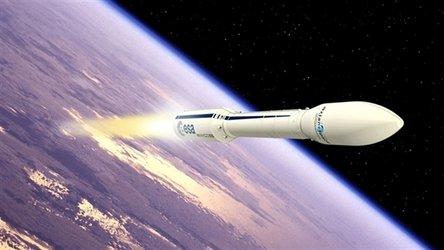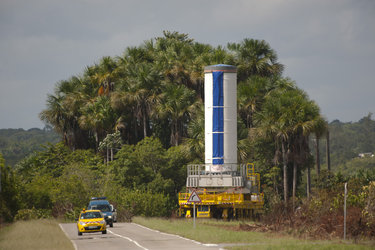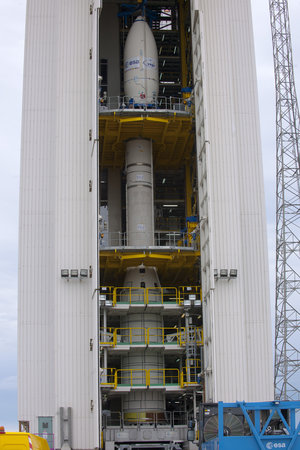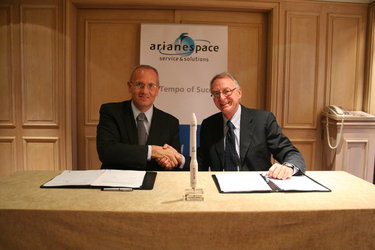Vega moves closer to its first liftoff
The integration of Vega’s first, second and third stages is now complete at Europe’s Spaceport in French Guiana. The new rocket is moving full speed ahead towards its maiden flight at the end of January.
The first Vega launch campaign began in November with the installation and testing inside the mobile gantry of the hundred-tonne solid-propellant first stage, the P80, and the Interstage-1/2 structure that links the first two stages.

The booster’s final acceptance included testing of the thrust vector control system. The large nozzle was swivelled to simulate different flight profiles. Electrical and avionics interface and functional tests were also performed.
The next step was to move the 30-tonne solid-propellant second stage, the Zefiro-23, from the Vega Booster Storage and Preparation Building, to the pad. As with the P80, the second stage underwent final acceptance, including testing of its thrust vector control system.
Finally, the 10-tonne Zefiro-9 solid-propellant third stage was added on top of the launcher last week, marking another milestone of the campaign. Electrical and functional tests are now underway.

The second and last Flight Readiness Review, held on 7 December, gave the go-ahead for the final preparation and launch.
In the coming days, the AVUM – Attitude &Vernier Upper Module – liquid-propellant fourth stage will be moved to the pad and added to the launcher.
Final preparations for launch in January

In parallel to the launcher activities, the LARES laser relativity satellite from Italy’s ASI space agency has undergone initial fit checks with the payload adapter and fairing.
A flexible system

By the end of the year, LARES and at least six small CubeSats and ALMASat-1 from European universities will be ready and enclosed in the fairing, well in time for the launch.
January will see the integration of the ‘upper composite’ – the fairing and payload – followed by final checkout of the fully integrated launcher and the countdown rehearsal.
The launch window for Vega’s maiden flight, VV01, opens on 26 January and closes in the first week of February.
This flight will pave the way for ESA’s missions to demonstrate flexibility and for commercial missions operated by launch provider Arianespace.
Preliminary feasibility studies for four Earth observation missions and one science mission are also underway.
A flexible system
Vega is designed to cope with a wide range of missions and payload configurations in order to respond to different market opportunities and provide great flexibility.
In particular, it offers configurations able to handle payloads ranging from a single satellite up to one main satellite plus six microsatellites.
Vega is compatible with payload masses ranging from 300 kg to 2500 kg, depending on the type and altitude of the orbit required by the customers. The benchmark is for 1500 kg into a 700 km-altitude polar orbit.















 Germany
Germany
 Austria
Austria
 Belgium
Belgium
 Denmark
Denmark
 Spain
Spain
 Estonia
Estonia
 Finland
Finland
 France
France
 Greece
Greece
 Hungary
Hungary
 Ireland
Ireland
 Italy
Italy
 Luxembourg
Luxembourg
 Norway
Norway
 The Netherlands
The Netherlands
 Poland
Poland
 Portugal
Portugal
 Czechia
Czechia
 Romania
Romania
 United Kingdom
United Kingdom
 Slovenia
Slovenia
 Sweden
Sweden
 Switzerland
Switzerland



































